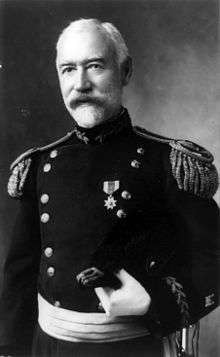Alexander Mackenzie (engineer)
Alexander Mackenzie (May 25, 1844 – February 23, 1921) was an American engineer.
Alexander Mackenzie | |
|---|---|
 Brigadier General Alexander Mackenzie | |
| Born | May 25, 1844 Potosi, Wisconsin |
| Died | February 23, 1921 (aged 76) Washington, D.C. |
| Allegiance | United States of America |
| Service/ | United States Army |
| Years of service | 1864 - 1908, 1917 |
| Rank | Major General |
| Commands held | Chief of Engineers |
| Battles/wars | American Civil War |
Mackenzie was born May 25, 1844, in Potosi, Wisconsin[1] and graduated from the United States Military Academy in 1864. Commissioned in the United States Army Corps of Engineers, he served with the Union Army in Arkansas in 1864-65. Mackenzie spent six years commanding a company of engineer troops at Willets Point, New York, that experimented in the use of torpedoes (a.k.a. mines) in coastal defense. In 1879 he began a 16-year stint as Rock Island District Engineer. He built 100 miles of wing dams on the upper Mississippi River and produced a 40-foot channel between St. Paul and the mouth of the Missouri River. Called to Washington in 1895, he became Assistant to the Chief of Engineers in charge of all matters relating to river and harbor improvements.[2] He was the first senior member of the Board of Engineers for Rivers and Harbors, which reviewed improvements submitted by Corps of Engineer officers. He was a member of the general staff corps and War College Board when appointed Chief of Engineers on January 23, 1904. In that capacity Mackenzie reported on the federal statutes relating to water power[3] for the Inland Waterways Commission, which was established by President Theodore Roosevelt in 1907 and presented in its preliminary report transmitted to Congress on February 26, 1908.[4]
Mackenzie retired May 25, 1908, as a major general, he was recalled to active duty in 1917 at age 73 as Northwest Division Engineer serving again in Rock Island, Illinois.[5]
General Mackenzie died of a stroke on February 23, 1921 at a bank in Washington, D.C.[1] He was buried in Milwaukee.[1]
See also
References
- "Gen. Mackenzie Dies of Apoplexy in Bank". Evening Star. February 24, 1921. p. 7. Retrieved September 29, 2017 – via Newspapers.com.

- "Office of History No. 52". United States Army Corps of Engineers. Archived from the original on 2008-02-04. Retrieved 2008-02-05.
- Alexander Mackenzie, Preliminary Report of the Inland Waterways Commission, Section 19, Statutes Relating to Water Power
- United States Inland Waterways Commission. Preliminary report of the Inland Waterways Commission. Message from the President transmitting a preliminary report, February 26, 1908.
- "Portraits and Profiles Chief Engineer - 1775 to Present:". United States Army Corps of Engineers. Archived from the original on 2008-05-31. Retrieved 2008-02-05.
External links
- Alexander Mackenzie at Find a Grave

| Military offices | ||
|---|---|---|
| Preceded by George Lewis Gillespie, Jr. |
Chief of Engineers 1904–1908 |
Succeeded by William Louis Marshall |